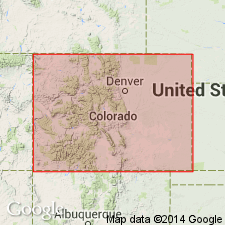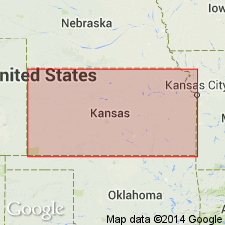
- Usage in publication:
-
- Cruise [member]
- Modifications:
-
- Overview
- AAPG geologic province:
-
- Denver basin
Summary:
Is lower [member] (of three) in Omadi [formation] at top of Dakota group in the Denver basin in northeastern CO, southeastern WY, and western NE. Chart (Plate 3) illustrates various nomenclatures for the basin. Chart was part of a paper titled "The Denver-Cheyenne Basin," presented by C. W. Sternberg and A. J. Crowley at Los Angeles A.A.P.G. meeting March 1952. Is shown above Skull Creek [formation] and below Huntsman [member]. Cruise is shown correlative with "J" sand, 3rd Dakota [sand], and Lower Muddy.
Source: GNU records (USGS DDS-6; Denver GNULEX).

- Usage in publication:
-
- Cruise sandstone member
- Modifications:
-
- First used
- Overview
- Dominant lithology:
-
- Sandstone
- AAPG geologic province:
-
- Las Animas arch
- Salina basin
- Central Kansas uplift
- Anadarko basin
Summary:
First used as lowest member of Omadi formation of Dakota group in subsurface of KS in Salina basin, Central Kansas uplift, Anadarko basin, and Las Animas arch. Overlies Lower Cretaceous Kiowa formation or Permian beds where Comanchean (Lower Cretaceous) is absent. Underlies Huntsman shale member (new) of Omadi formation. Consists of light-gray, gray, or light-brown sandstone with fine- to medium-grained, subrounded, friable quartz fragments and minor amounts of mica, glauconite, and carbonaceous material; some interbedded siltstone and shale; siderite pellets present locally. Becomes more shaly and clayey eastward and sandstone grades into siltstone. Thickness is 100 to 200 ft. Is at least in part marine on basis of fossils. Is correlated with Terra Cotta member of Dakota formation in north-central KS. May be equivalent to Cockrum sandstone of southwestern KS; also "J" sandstone of some. Is assigned to Gulfian Series (Upper Cretaceous). Derivation of name not given.
Source: GNU records (USGS DDS-6; Denver GNULEX).
For more information, please contact Nancy Stamm, Geologic Names Committee Secretary.
Asterisk (*) indicates published by U.S. Geological Survey authors.
"No current usage" (†) implies that a name has been abandoned or has fallen into disuse. Former usage and, if known, replacement name given in parentheses ( ).
Slash (/) indicates name conflicts with nomenclatural guidelines (CSN, 1933; ACSN, 1961, 1970; NACSN, 1983, 2005, 2021). May be explained within brackets ([ ]).

